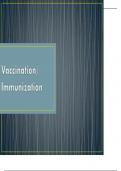Summary
Summary IMMUNOLOGY : VACCINATION/IMMUNIZATION GUARANTEED PASS QUALITY NOTES
- Course
- MEDICINE 111 (IMMUNOLOGY)
- Institution
- Cambridge College
Immunization is the means of providing specific protection against most common and damaging pathogens. • The mechanism of immunity depends on the location of the pathogen and the mechanism of its pathogenesis. • If the mechanism of pathogenesis involves exotoxins, the only immune mechanism...
[Show more]



